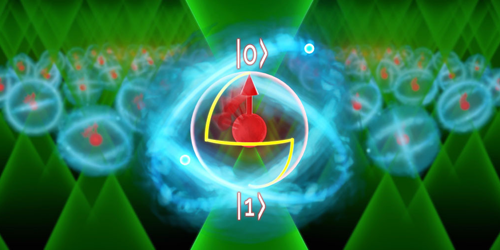A New Option for Neutral-Atom Quantum Computing
According to Jeff Thompson, a physicist at Princeton University, now is an exciting time for quantum computing, as many different quantum-computing platforms have reached large system sizes and can perform high-fidelity operations. Thompson’s claim is backed up by the diversity of systems that have recently achieved significant milestones, such as quantum computers based on superconducting circuits, optical interferometers, trapped ions, and neutral atoms (see Viewpoint: Quantum Leap for Quantum Primacy, Synopsis: The Smallest Quantum Computer Yet, and Synopsis: Neutral-Atom Quantum Computers Are Back in the Race). Now, Thompson and his colleagues, and Adam Kaufman at JILA in Colorado and his colleagues, have demonstrated a new kind of qubit for neutral-atom quantum computers. The qubit’s properties allow it to robustly store and manipulate quantum information [1, 2].
Neutral-atom qubits store information in their spin states. So far, most neutral-atom experiments have used alkali metals, for which the necessary trapping and cooling techniques are highly advanced. Alkali-metal atoms have a drawback, however: the electronic spin states used to store quantum information can be corrupted by the light field used for trapping the atoms. As an alternative, physicists have experimented with alkaline-earth atoms, which can store information more robustly in their nuclear spin states. This possibility has been demonstrated in strontium-87 ( 87Sr), but the multiple spin states of this isotope’s large nuclear spin make it difficult to use to implement a simple two-level qubit.
In their demonstrations, Thompson, Kaufman, and their respective teams used ytterbium-171 ( 171Yb) atoms. Like 87Sr atoms, the spin states of 171Yb atoms are robust to perturbation by the optical trap. But unlike 87Sr atoms, 171Yb atoms have a nuclear spin of 1/2, making it easier to manipulate spin-state qubits made from this isotope. Both teams show that 171Yb atoms can be cooled and trapped using optical tweezers and that the nuclear spins of 171Yb atoms can be initialized, manipulated using optical or radio-frequency fields, and measured. In addition, Kaufman’s group demonstrates that a ten-by-ten atomic lattice can be loaded with 171Yb atoms rapidly, with few defects, and then cooled to nearly absolute zero for high-fidelity qubit manipulations. Thompson’s team, meanwhile, demonstrates a two-qubit gate operation using pairs of adjacent 171Yb atoms.
Although neutral-atom quantum computers have not yet been explored as thoroughly as other platforms, recent advances in atom-manipulation techniques mean that they are catching up. Kaufman thinks that, eventually, physicists will be able to exploit the varied energy structures of different atoms to implement quantum computers that are scalable and that can be used in diverse applications such as metrology. Thompson says that the nuclear spin sublevels of 171Yb atoms have been predicted to offer an especially effective method of quantum error correction.
–Marric Stephens
Marric Stephens is a Corresponding Editor for Physics Magazine based in Bristol, UK.
References
- S. Ma et al., “Universal gate operations on nuclear spin qubits in an optical tweezer array of 171Yb atoms,” Phys. Rev. X 12, 021028 (2022).
- A. Jenkins et al., “Ytterbium nuclear-spin qubits in an optical tweezer array,” Phys. Rev. X 12, 021027 (2022).




